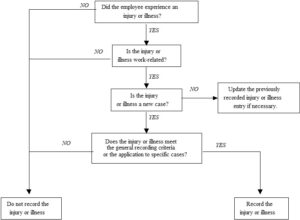By Stephen S. Stankavage, Director of Environmental, Safety & Health, Print & Graphic Communications Association
Greetings safety fans!
It is appropriate at this time of year to discuss what makes an injury “recordable”, as in, it must be recorded on the OSHA 300 log. I’ve been receiving many questions about this, and I’d thought I would spenda little time talking about it. First, your best source is the 29CFR1904. However, this can be a little confusing at times, so I hope I can clear it up a little for everyone. Moreover, you can also find many answers to questions by accessing OSHA’s detailed guidance for Recordkeeping rule at: https://www.osha.gov/recordkeeping/entry-faq

An injury first must be:
- Work Related
- A New Case – otherwise, update the old case
- And meet general recordkeeping criteria which equates to
- *Death, in-patient hospitalization, amputation, or eye loss*
- Days away from work
- Restricted work or transfer to another job
- Loss of Consciousness
- A significant injury or illness diagnosed by a physician or other licensed health care professional including COVID-19 infection
The general recording criteria is the one that most people find difficult to decipher, so let’s break them down a bit better.
Death – the most serious and the most tragic of all injuries; must be recorded to include the date of the death and 180 days of lost time. This is also one of the cases where you must call OSHA DIRECTLY via phone within 8 hours of the occurrence and report the fatality. Death of an employee that occurs 30 or more days after the work-related incident DOES NOT NEED to be reported to OSHA but is still documented as 180 days lost time.
In-patient hospitalization, amputation, or eye loss must also be reported to OSHA DIRECTLY via phone within 24 hours of learning of the prognosis if it’s within 24 hours of the incident occurring.
Furthermore, any overdose death, hospitalization, loss of consciousness, or treatment within the facility as a direct result of an illegal substance (or a legal substance that is not prescribed as a result of a workplace injury) is not considered work-related and does not need to be reported unless another employee is injured as a result of the overdose.
Days away from work – Equates to an employee’s injuries which so severe that they require bed rest or must remain in the hospital or at home for any amount of days AFTER the day of injury. Days don’t start counting until the next full day. For example; say an employee is injured Monday morning, and the physician tells the employee to take the remainder of Monday and all of Tuesday off. It is recorded as one lost day for Tuesday. However, if the physician tells the employee to take the remainder of Monday off but report to work Tuesday, then it isn’t counted as a lost time injury and may not even be a recordable injury. Now, if the physician tells the employee to report to work on Tuesday but with the following restrictions… the injury is still recordable but not as a lost time. It’s recorded as our next category.
Restricted work or transfer to another job – This type of injury restricts the employee from performing some function of their job. Whether it be not standing for long periods, use of a body part, or lifting restrictions etc. Moreover, if the employee must be “transferred” to another job temporarily because of their injury, it also counts in this category. This category can leave many people scratching their heads. For example: employee restriction is that they can’t stand in place for longer than two hours, but their job is desk work where they sit eight hours of the day, would that be a recordable or not? The answer is yes. The reason involves the nature of the injury and what they were doing at the time of the injury. So in our case, an office worker who can’t stand longer than two hours was injured when she tripped over a garbage can walking to the file archive room to return some files. As an office employee, walking to and from the archive room is a function of their normal job, therefore the case is recordable.
Loss of consciousness – This one is self-explanatory, but remember, it must be work related. If the loss of consciousness was caused by medications not work related or a personal medical condition not a direct result of a workplace injury, it’s not recordable. Loss of consciousness from a heat illness in your shop would be, however. The amount of time the employee was unconscious is irrelevant. Unconscious equals recordable.
A significant injury or illness diagnosed by a physician or other licensed health care professional – This category generally causes the most confusion. What is a significant injury? Generally, it’s any injury or illness that requires more treatment than “First-Aid”. That includes, but is not limited to, broken bones, positive X-rays including MRI scans, non-bendable splints, stitches, staples, wound adhesives, IV fluids, prescription medications of prescription strength, and surgeries. You must remember that just because you send an employee to the doctor doesn’t always mean that the injury is recordable. You must look at the treatment that was performed and if it was “above” first-aid level treatment.
Next post we’ll look at some instances that can cause the confusion of “is it recordable or not!” We’ll look at the infamous “The employee slipped on the ice in the parking lot case”. The “The doctor gave him lost time, so we put him on vacation” case. The “They were supposed to come to work but called in and said they can’t” case and the other side, “He was supposed to stay home but came to work anyway” case and many other favorites! Stay tuned! And as always, I and PGCA are always here to help if you have questions about your OSHA 300 logs.
Stephen S. Stankavage, Director of Environmental Safety & Health
Print & Graphic Communications Association
(570) 579-6497, sstankavage@printcommunications.org




